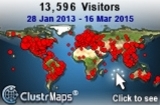Our youngest has Respiratory Syncytial Virus, more commonly known as RSV. Our Paediatrics Doctor at South Louisville Paediatrics has prescribed an albuterol nebulizer shaped like a seal, which seems to be helping a great deal. We’ve been through two days of treatments, at three times per day, and the fever seems to be gone now. The cough is still present and accounted for, but not nearly as intense. Still, it’s made for a long day.
Tomorrow, I should be posting some creative writing advise. Most of the blog post is written, but it just didn’t get finished. So it goes when one of the herd is lamed up.
Anyway, here is what the A.D.A.M. Medical Encyclopedia has to say about RSV:
Respiratory syncytial virus (RSV)
RSV; Palivizumab; Respiratory syncytial virus immune globulin
Last reviewed: January 24, 2011.
Respiratory syncytial virus (RSV) is a very common virus that leads to mild, cold-like symptoms in adults and older healthy children. It can be more serious in young babies, especially to those in certain high-risk groups.
Causes, incidence, and risk factors
RSV is the most common germ that causes lung and airway infections in infants and young children. Most infants have had this infection by age 2. Outbreaks of RSV infections most often begin in the fall and run into the spring.
The infection can occur in people of all ages. The virus spreads through tiny droplets that go into the air when a sick person blows their nose, coughs, or sneezes.
You can catch RSV if:
-
A person with RSV sneezes, coughs, or blows their nose near you
-
You touch, kiss, or shake hands with someone who is infected by the virus
-
You touch your nose, eyes, or mouth after you have touched something contamined by the virus, such as a toy or doorknob.
RSV often spreads very rapidly in crowded households and day care centers. The virus can live for a half an hour or more on hands. The virus can also live for up to 5 hours on countertops and for several hours on used tissues.
The following increase the risk for RSV:
Symptoms
Symptoms vary and differ with age. They usually appear 4 – 6 days after coming in contact with the virus.
Older children usually have only mild, cold-like symptoms, such as cough, stuffy nose, or low-grade fever.
Infants under age 1 may have more severe symptoms and often have the most trouble breathing.
In general, RSV symptoms include:
Signs and tests
Many hospitals and clinics can rapidly test for RSV using a sample of fluid taken from the nose with a cotton swab.
Treatment
Antibiotics do not treat RSV.
Mild infections go away without treatment.
Infants and children with a severe RSV infection may be admitted to the hospital . Treatment will include:
A breathing machine (ventilator) may be needed.
Expectations (prognosis)
Rarely, RSV infection can cause death in infants. However, this is unlikely if the child is seen by a health care provider in the early stages of the disease .
More severe RSV disease may occur in the following infants:
-
Premature infants
-
Infants with chronic lung disease
-
Infants whose immune system does not work well
-
Infants with certain forms of heart disease
Complications
In young children, RSV can cause:
Children who have had RSV bronchiolitis may be more likely to develop asthma.
Calling your health care provider
Call your health care provider if breathing difficulties or other symptoms of this disorder appear. Any breathing difficulties in an infant are an emergency. Seek medical attention right away.
Prevention
A simple way to help prevent RSV infection is to wash your hands often, especially before touching your baby. It is important to make certain that other people, especially caregivers, take steps to avoid giving RSV to your baby.
The following simple steps can help protect your baby from getting sick:
-
Insist that others wash their hands with warm water and soap before touching your baby.
-
Have others avoid contact with the baby if they have a cold or fever. If necessary, have them wear a mask.
-
Be aware that kissing the baby can spread RSV infection.
-
Try to keep young children away from your baby. RSV is very common among young children and easily spreads from child to child.
-
Do not smoke inside your house, car, or anywhere near your baby. Exposure to tobacco smoke increases the risk of RSV illness.
Parents of high-risk young infants should avoid crowds during outbreaks of RSV. Moderate-to-large outbreaks are often reported in the local news and newspapers to provide parents with an opportunity to avoid exposure.
The drug Synagis (palivizumab) is approved for the prevention of RSV disease in children younger than 24 months who are at high risk for serious RSV disease. Ask your doctor if your child should receive this medicine.
References
- Committee on Infectious Diseases. Modified recommendations for use of palivizumab for prevention of respiratory syncytial virus infections. Pediatrics. 2009;124:1694-1701.
- Respiratory Syncytial Virus. In: Mandell GL, Bennett JE, Dolin R, eds. Principles and Practice of Infectious Diseases. 7th ed. Philadelphia, Pa: Elsevier Churchill Livingstone; 2009:chap158.
- Cincinnati Children’s Hospital Medical Center. Evidence based clinical practice guideline for medical management of bronchiolitis in infants less than 1 year of age presenting with a first time episode. Cincinnati (OH): Cincinnati Children’s Hospital Medical Center; 2006 May. 13 p.
- Mcintosh K. Respiratory syncytial virus. In: Kliegman RM, Behrman RE, Jenson HB, Stanton BF. Nelson Textbook of Pediatrics. 18th ed. Philadelphia, Pa: Saunders Elsevier;2007:chap 257.
-
Review Date: 1/24/2011.
Reviewed by: Neil K. Kaneshiro, MD, MHA, Clinical Assistant Professor of Pediatrics, University of Washington School of Medicine. Also reviewed by David Zieve, MD, MHA, Medical Director, A.D.A.M., Inc.













